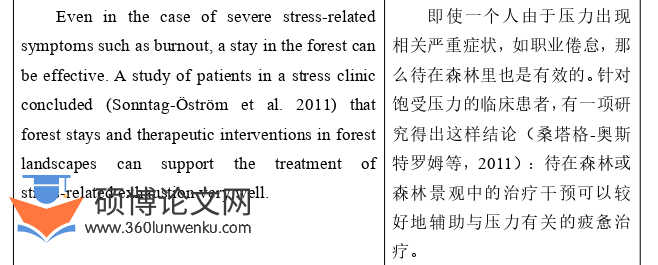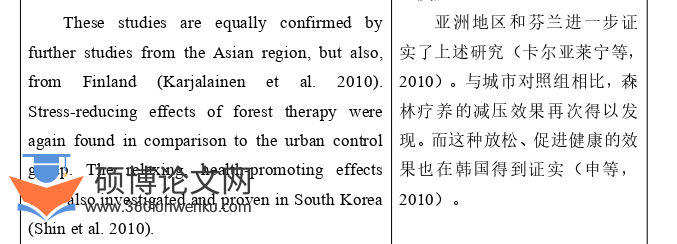本文是一篇英语论文,本文大量使用专业术语,句群和段落间逻辑性强,句式较复杂。因此译文需要在忠实于原文的前提下满足目标读者的阅读需求。在变译理论指导下,译者在翻译过程中采取针对性的变通手段,包括增、减、编、述、并,处理词汇、句子和句群之间的逻辑关系。
Chapter 1 Introduction to the Translation Project
1.1 Text Selection
The source text of this translation project is from Forest Therapy---The Potentialof the Forest for Your Health,which was published by Springer in March 2022.Itconsists of seven chapters from which the translator selects the fourth chapter,“Effects of Spending Time in the Forest:Current Studies”,as the translation material.There has been no Chinese translation since its publication.
Originally Angela Schuh and Gisela Immich,both serving at the PettenkoferSchool of Public Health at Ludwig Maximilians University of Munich(LMU)inGermany,wrote the book in German.The English version was completed with thehelp of artificial intelligence(provided by DeepL.com)and Ms.Apurva Sarwade whosubsequently revised it mainly in terms of content.Angela,a professor of medicalclimatology and Academic Director of Public Health and Health services Researchand an expert in climate therapy and resort medicine,is responsible for the departmentof Medical Climatology,Resort Medicine and Prevention.Gisela serves as a researchassistant to the academic Director of Public Health and Health Services Research,studying forest retreats,health promotion and prevention and various naturopathiccures.
There are two reasons for choosing its English version as the source text.First,nowadays forest therapy is flourishing in the world.The translator who has greatinterest in this field,through searching various online resources,finds that this bookrelated to forest therapy without Chinese version.Second,German scholars have themost abundant literature and practice,as well as the most authoritative andcutting-edge research results in this field,as Germany is the birthplace of foresttherapy;while China is still in the exploration stage,and even some Chinese peopledo not hear the therapy.The translator aims to present the most advanced informationto Chinese readers,thus promoting the development of forest therapy,making up forthe academic gap,and better benefiting the people’s livelihood.

英语论文怎么写
................................
1.2 Text Type and Language Features
Peter Newmark(1916-2011)divides text types into expressive text,informativetext and vocative text in his book A Textbook of Translation.In his opinion,metaphor,personification,exaggeration and other rhetorical devices,as well as some words andsentence patterns with personal marks are applied in the expressive texts to expressthe author’s feelings,attitudes and value;informative texts is to convey informationand reflect objective facts;and vocative texts,is to urge readers to feel,to think and toact in accordance with the author’s intention.Forest Therapy---The Potential of theForest for Your Health is an academic book aiming to show the facts and backgroundfor relevance of forest therapy in the contemporary life on a scientific basis.It is alsoof use for those who are interested in the effects of nature and forests on human healthand need well-founded information on this.Therefore,it is an informative text.During translation process,it is core to convey the information in the source textaccurately,both in form and content.The features of the source text are as follows:
(1)Lexical features:many abbreviations appear in the source text,such as“ADHD”(Attention Deficit and Hyperactivity Disorder,注意缺陷多动障碍),“EEG”(Electroencephalogram,脑电图),“BMI”(Body Mass Index,体质指数),etc.Moreover,there are quite a few medical terms such as“chronic bronchitis”(慢性支气管炎),“psoriasis”(牛皮癣),“post-traumatic stress disorder”(创伤后应激障碍).Therefore,the first thing in this translation is to make sure their equivalents inChinese in advance.
(2)Syntactic features:a number of long sentences are used in the original text toenhance coherence and logic and convey information precisely of the text.Manycomplex and compound sentences can be found in the source text.For example,“Although a pilot study provides initial indications that breast cancer patients whohave undergone surgery can experience an immune stimulation through a 14-dayforest therapy,no statements in this direction should be made here based on thecurrent state of knowledge,and thereby possibly raising false hopes!”is a typicalsentence.
..................................
Chapter 2 Description of the Translation Process
2.1 Pre-translation Preparation
Before translating,the translator looks up a lot of books and documents related toforest therapy,forest bathing and forest climatology.The parallel texts she has readmainly include Analysis of the Development Process and Characteristics of ForestTherapy and Its Research Prospect(s《森林疗养发展历程与特征分析及研究展望》),Forest Medicine(《森林医学》),and Application of Forest Bathing in Health Nursing(《森林浴在健康疗养护理中的应用》),etc.In addition,the translator reads throughthe book to understand the main ideas and writing styles of the book,which is crucialfor the subsequent translation work.Meanwhile,the translator learns the origin offorest therapy,its development in various countries and its application in today’sworld through some search engines(Baidu,Bing)and online communities(Douban,Zhihu).
After selecting the source text,the author studies different translation theoriessuch as“Register Theory”,“Schema Theory”and“Translation Variation Theory”anddetermines“Translation Variation Theory”as a guide to the translation in accordancewith linguistic features of the source text.Then she searches and reads a large numberof books and journals about this theory on CNKI,including Translation VariationTheory,Studies on Translation Variation,etc.
As there are a number of professional terms in the source text,it is necessary tofind out their equivalents in Chinese before translating.So many terminologywebsites such as CNKI translation assistant are visited by the translator to ensure theaccuracy of terms.After that,the translator formulates a glossary which is provided inthe appendix.
................................
2.2 During Translation
In the process of translation,the translator adopts Longman Dictionary ofContemporary English(《朗文当代高级英语词典》),Oxford Advanced Learner’sEnglish-Chinese Dictionary(《牛津高阶英汉双解词典》)and other dictionaries thatare supplemented by network resources(CNKI,Wanfang Database,Wikipedia,Douban,Zhihu,etc).
When understanding the source text,the translator encounters some words thatwere difficult to understand.Then the translation assistant of CNKI is applied to avoidmistranslation.For example,when translating“presence of structures/patterns”,thetranslator would fail to determine its Chinese version without the help of thistranslation assistant.
Furthermore,the translator took the context and logic into account to make thetranslated text more precise.For example,when translating sentences with casual link,the translator adopts flexible means of“editing”,putting the cause before the result inorder to make the translation be in line with reading habits of Chinese readers.
..................................
Chapter 3 Introduction to Translation Variation Theory ............................. 7
3.1 Background of Translation Variation Theory .................................... 7
3.2 Translation Strategies of Translation Variation Theory ..................... 8
Chapter 4 Case Analysis ............................. 11
4.1 Addition .......................................... 11
4.2 Omission .................................. 13
Chapter 5 Conclusion .................... 22
5.1 Gains from the Translation Project ......................... 22
5.2 Limitations ........................... 22
Chapter 4 Case Analysis
4.1 Addition

英语论文参考
Addition refers to increasing more information based on the original content,which can be divided into three ways:interpretation,comment and writing.Whentarget readers do not know much about the translated content or the original text is tooprofessional and difficult to understand,it is necessary to add extra valuableinformation to explain and enhance the readability of the source text.The above threemethods make readers better understand the information conveyed in the original text.After addition,the information of the target text is more than that of the original text.
The selected text is an academic work which is an informative text withobjective contents,ergo it is unnecessary to apply“comment”to the translation.Interpretation is to explain a certain part of the source text in the translation.It ismainly used at the lexical level to explain the information which is easy to be doubtedor cause misunderstanding.Writing that is adding extra messages to the translated text,is mainly reflected in the syntactic level so that the translated text is coherent and easyto understand.
.....................................
Chapter 5 Conclusion
5.1 Gains from the Translation Project
First of all,this translation practice helps the translator accumulate knowledgeand professional terms,and master features of informative texts which lays a goodfoundation for the later translation work.
Secondly,in the translation practice,the translator finds that it is highly feasibleto apply Translation Variation Theory to the informative texts by different translationstrategies:addition is employed to supplement necessary information related to thesource text;omission aims to delete redundant contents;editing,narration andcombination make adjustments to the original text in terms of the form,order orlanguage.Thus the translation appears more concise and accommodates target readers’demands.
Furthermore,the translator realizes the importance of theoretical learning.Although Translation Variation Theory is eventually selected as the theoretical basis,the translator has studied many translation theories in the pre-translation preparationperiod,such as Register Theory,Schema Theory and so on.She is deeply aware that itis necessary to apply a translation theory properly and there is still a long way to go topromote her theoretical study.
reference(omitted)
